Alpine INE-NAV-30, INE-NAV-38, INE-S920HD, INE-Z928HD User Manual
User Manual
Alpine Navigation
Navigation software for the Alpine
INE-S920HD/INE-Z928HD/INE-NAV-30/INE-NAV-38
US English (EN)
Thank you for choosing the Alpine unit as your navigator. Start using your device right away. This document is the detailed description of the navigation software. You can easily discover the software while you are using it; however, we still recommend that you read this manual to fully understand the screens and features.
2
Table of contents |
|
1 Warnings and Safety information ........................................................................................... |
6 |
2 Getting started ........................................................................................................................... |
7 |
2.1 Buttons and other controls on the screen ....................................................................................... |
8 |
2.1.1 Using keyboards.......................................................................................................................................... |
9 |
2.1.2 Beyond single screen tap........................................................................................................................... |
10 |
2.2 Map screen.................................................................................................................................. |
11 |
2.2.1 Navigating on the map .............................................................................................................................. |
11 |
2.2.2 Position markers........................................................................................................................................ |
14 |
2.2.2.1 Vehimarker and Lock-on-Road.................................................................................................................................. |
14 |
2.2.2.2 Selected map location (Cursor) and selected map object ........................................................................................ |
14 |
2.2.3 Objects on the map.................................................................................................................................... |
14 |
2.2.3.1 Streets and roads......................................................................................................................................................... |
14 |
2.2.3.2 Turn preview and Next street ..................................................................................................................................... |
15 |
2.2.3.3 Lane information and Signposts ................................................................................................................................ |
16 |
2.2.3.4 Junction view............................................................................................................................................................... |
16 |
2.2.3.5 Freeway exit services.................................................................................................................................................. |
17 |
2.2.3.6 3D object types............................................................................................................................................................ |
17 |
2.2.3.7 Elements of the active route ....................................................................................................................................... |
18 |
2.2.3.8 Traffic events ............................................................................................................................................................... |
18 |
2.2.4 Manipulating the map ............................................................................................................................... |
19 |
2.2.5 Checking the details of the current position (Where Am I?)..................................................................... |
21 |
2.3 Navigation menu ......................................................................................................................... |
22 |
3 On-road navigation ................................................................................................................. |
23 |
3.1 Selecting the destination of a route .............................................................................................. |
23 |
3.1.1 Entering an address or a part of the address.............................................................................................. |
23 |
3.1.1.1 Entering an address (United States).......................................................................................................................... |
24 |
3.1.1.2 Entering an address (Canada)................................................................................................................................... |
26 |
3.1.1.3 Entering an address (Mexico).................................................................................................................................... |
28 |
3.1.1.4 Entering an address starting with the street name (in the United States only) ...................................................... |
30 |
3.1.1.5 Entering the midpoint of a street as the destination ................................................................................................. |
32 |
3.1.1.6 Selecting an intersection as the destination .............................................................................................................. |
33 |
3.1.1.7 Selecting a city/town center as the destination ......................................................................................................... |
35 |
3.1.1.8 Entering an address with a ZIP code ........................................................................................................................ |
36 |
3.1.1.9 Tips on entering addresses quickly............................................................................................................................ |
38 |
3.1.2 Selecting the destination from the Places of Interest ................................................................................ |
39 |
3.1.2.1 Quick search for a Place of Interest .......................................................................................................................... |
39 |
3.1.2.2 Searching for a Place of Interest using preset categories ....................................................................................... |
40 |
3.1.2.3 Searching for a Place of Interest by category........................................................................................................... |
42 |
3
|
3.1.2.4 Searching for a Place of Interest by name ................................................................................................................ |
45 |
3.1.3 Using the free form search ........................................................................................................................ |
48 |
|
3.1.4 Selecting a map location as the destination............................................................................................... |
49 |
|
3.1.5 Selecting the destination from your Address Book................................................................................... |
50 |
|
3.1.6 Selecting a recent destination from the History ........................................................................................ |
51 |
|
3.1.7 Entering the coordinate of the destination ................................................................................................ |
52 |
|
3.1.8 Navigate to a location stored in a picture.................................................................................................. |
53 |
|
3.1.9 Building a route from the list of destinations (Create Route) ................................................................... |
54 |
|
3.2 |
Viewing the entire route on the map............................................................................................. |
55 |
3.3 |
Modifying the route ..................................................................................................................... |
55 |
3.3.1 Selecting a new destination when already having a route: New Route, Waypoint or Final Destination .. |
55 |
|
3.3.2 Setting a new starting position for the route ............................................................................................. |
56 |
|
3.3.3 Editing the list of destinations (Edit Route) .............................................................................................. |
57 |
|
3.3.4 Canceling the active route......................................................................................................................... |
58 |
|
3.3.5 Checking route alternatives....................................................................................................................... |
58 |
|
3.4 |
Saving a location as an Address Book entry................................................................................. |
59 |
3.5 |
Saving a location as an alert point............................................................................................... |
60 |
3.6 |
Editing an alert point................................................................................................................... |
60 |
3.7 Watching the simulation of the route............................................................................................ |
61 |
|
4 Off-road navigation................................................................................................................. |
63 |
|
4.1 |
Selecting the destination of the route ........................................................................................... |
63 |
4.2 |
Navigating in off-road mode ........................................................................................................ |
63 |
5 Reference Guide ...................................................................................................................... |
64 |
|
5.1 |
Concepts ..................................................................................................................................... |
64 |
5.1.1 Smart Zoom .............................................................................................................................................. |
64 |
|
5.1.2 Route calculation and recalculation .......................................................................................................... |
64 |
|
5.1.3 Green routing ............................................................................................................................................ |
66 |
|
5.1.4 Speed limit warning .................................................................................................................................. |
67 |
|
5.1.5 Traffic information in route planning ....................................................................................................... |
67 |
|
|
5.1.5.1 Historical traffic.......................................................................................................................................................... |
67 |
|
5.1.5.2 Real-time traffic information (TMC) (INE-Z928HD/INE-NAV-38 only)................................................................ |
67 |
5.2 |
Information menu ........................................................................................................................ |
69 |
5.3 |
Settings menu .............................................................................................................................. |
70 |
5.3.1 Sound and Warnings ................................................................................................................................. |
72 |
|
5.3.2 Traffic settings .......................................................................................................................................... |
74 |
|
5.3.3 Route settings............................................................................................................................................ |
74 |
|
5.3.4 Map settings .............................................................................................................................................. |
78 |
|
5.3.5 Visual guidance settings............................................................................................................................ |
79 |
|
|
4 |
|
|
5.3.6 Regional settings....................................................................................................................................... |
81 |
|
5.3.7 Trip monitor settings................................................................................................................................. |
81 |
|
5.4 Trip monitor ................................................................................................................................ |
82 |
6 |
Glossary.................................................................................................................................... |
83 |
7 |
Copyright note ......................................................................................................................... |
85 |
5
1 Warnings and Safety information
The navigation system helps you find your way to your destination with a connected GPS receiver. The software does not transmit your GPS position; others cannot track you.
It is important that you look at the display only when it is safe to do so. If you are the driver of the vehicle, we recommend that you operate your software before you start your journey. Plan the route before your departure and stop if you need to change the route.
You must obey the traffic signs and follow the road geometry. If you deviate from the recommended route, your software changes the instructions accordingly.
6
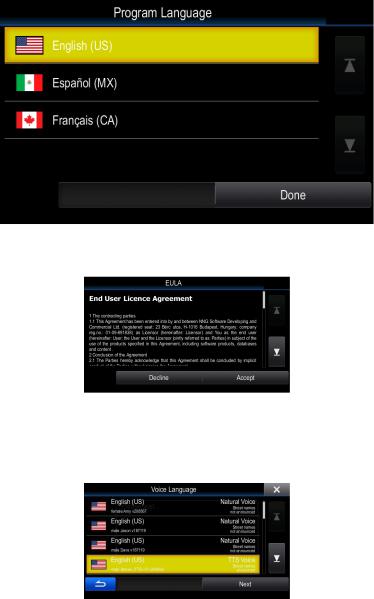
2 Getting started
When using the navigation software for the first time, an initial setup process starts automatically. Do as follows:
1.Select the written language of the application interface. Later you can change it in Regional settings (page 81).
2.Read the End User License Agreement. Tap  to continue.
to continue.
3.The Configuration wizard starts. Tap  to continue.
to continue.
4.Select the language and speaker used for voice guidance messages. Later you can change it in Sound and Warnings settings (page 81).
5.If needed, modify the time format and unit settings. Later you can change them in Regional settings (page 81).
7
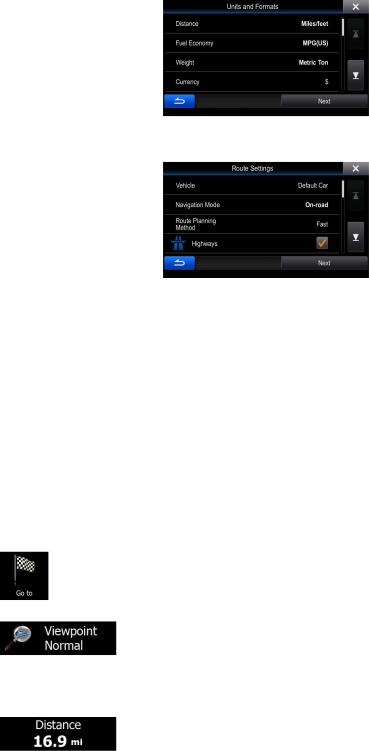
6.If needed, modify the default route planning options. Later you can change them in Route settings (page 74).
7.The initial setup is now complete. The Configuration wizard can be restarted later from the Settings menu (page 70).
After the initial setup, the Map screen appears and you can start using the software.
2.1 Buttons and other controls on the screen
When you are using the software, you usually tap buttons on the touch screen.
You only need to confirm selections or changes if the application needs to restart, it needs to perform a major reconfiguration, or you are about to lose some of your data or settings. Otherwise, the software saves your selections and applies the new settings without confirmation as soon as you use the controls.
Type |
Example |
Description |
How to use it |
|
|
|
|
Button |
|
Tap it to initiate a function, to |
Tap it once. |
|
|
open a new screen, or to set a |
|
|
|
parameter. |
|
|
|
|
|
Button |
|
Some buttons display the |
Tap it once. |
with value |
|
current value of a field or setting. |
|
|
|
Tap the button to change the |
|
|
|
value. After the change, the new |
|
|
|
value is shown on the button. |
|
|
|
|
|
Icon |
|
Shows status information. |
Some icons also function as a |
|
|
button. Tap them once. |
|
|
|
|
|
|
|
|
|
8
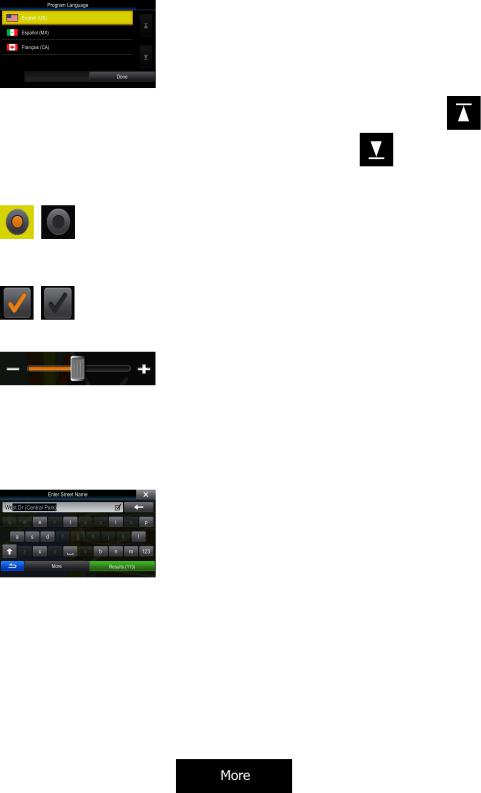
List |
|
When you need to select from |
Grab the list anywhere and |
|
|
|
several options, they appear in a |
slide your finger up or down. |
|
|
|
list. |
Depending on the speed of the |
|
|
|
|
sliding, the list will scroll fast or |
|
|
|
|
slow, only a bit or till the end. |
|
|
|
|
Alternatively, move between |
|
|
|
|
pages with the |
and |
|
|
|
buttons and tap the |
|
|
|
|
value that you want. |
|
|
|
|
|
|
Radio |
|
When there are only a few |
Tap one of the buttons to |
|
button |
|
choices, radio buttons may be |
select a new value. |
|
|
|
used instead of lists. Only one |
|
|
|
|
value can be selected. |
|
|
|
|
|
|
|
Switch |
|
When there are only two |
Tap it to turn the switch on or |
|
|
|
choices, a checkmark shows |
off. |
|
|
|
whether the feature is enabled. |
|
|
|
|
|
|
|
Slider |
|
When a feature can be set to |
∙ Drag the handle to |
|
|
|
different values in a range, the |
move the slider to its |
|
|
|
software shows an indicator on |
new position. |
|
|
|
a gauge that displays and sets |
∙ Tap the slider where |
|
|
|
the value. |
||
|
|
|
you want the handle to |
|
|
|
|
appear; the thumb |
|
|
|
|
jumps there. |
|
|
|
|
|
|
Virtual |
|
Alphabetic and alphanumeric |
Each key is a touch screen |
|
|
button. |
|
||
keyboard |
|
keyboards to enter text and |
|
|
|
|
|
||
|
|
numbers. |
|
|
|
|
|
|
|
2.1.1 Using keyboards
You only need to enter letters or numbers when you cannot avoid it. You can type with your fingertips on the full-screen keyboards and you can switch between various keyboard layouts, for example English, Greek or numerical.
Task |
|
Instruction |
|
|
|
Switching to another keyboard |
|
|
layout, for example from an |
Tap the |
button and select the new keyboard layout |
English keyboard to a Greek |
||
keyboard |
from the list. |
|
|
|
|
|
|
9 |

Correcting your entry on the |
|
|
|
|
keyboard |
Tap |
to remove the unneeded character(s). |
||
|
||||
|
Tap and hold the button to delete several characters or the entire input |
|||
|
string. |
|
|
|
|
|
|
|
|
Entering a space, for example |
|
|
|
|
between a first name and a |
Tap the |
button at the bottom center of the screen. |
||
family name or in multi-word |
||||
street names |
|
|
|
|
|
|
|
|
|
Entering upper and lower case |
When entering a text, the first character appears in upper case while |
|||
letters |
||||
|
|
|
||
|
the rest of the text is in lower case. Tap |
to enter an upper case |
||
|
letter or tap twice to turn on Caps Lock. Tap again and lower case |
|||
|
letters return. |
|
||
|
|
|
|
|
Entering symbols |
|
|
|
|
|
Tap |
to switch to a keyboard offering numeric and symbol |
||
|
characters. |
|
||
|
|
|
|
|
Finalizing the keyboard entry |
|
|
|
|
(accepting the suggested |
Tap |
. |
|
|
search result) |
|
|||
|
|
|
||
|
|
|
|
|
Finalizing the keyboard entry |
|
|
|
|
(opening the list of search |
Tap |
. |
|
|
results) |
|
|||
|
|
|
|
|
Finalizing the keyboard entry |
|
|
|
|
(saving your input) |
Tap |
. |
|
|
|
|
|||
|
|
|
|
|
Canceling the keyboard entry |
|
|
|
|
(returning to the previous |
Tap |
. |
|
|
screen) |
|
|||
|
|
|
||
|
|
|
|
|
2.1.2 Beyond single screen tap
You usually need to tap the screen only once. However, some useful features can be accessed with combined touch screen tapping. Those are the following:
Action |
Details |
|
|
10
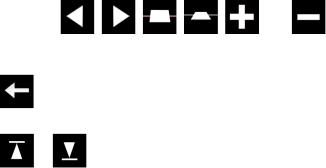
Tapping and holding the |
Tap and keep pressing the following buttons to reach extra functions: |
|||||||
screen |
|
|
|
|
|
|
|
|
|
∙ |
Tap and hold any of the |
, |
, |
, |
, |
, and |
|
|
|
buttons on the Map screen: you can rotate, tilt or scale the map |
||||||
|
|
continuously. |
|
|
|
|
|
|
|
∙ |
Tap and hold |
on keyboard screens: you can delete several |
|||||
|
|
characters quickly. |
|
|
|
|
|
|
|
∙ |
Tap and hold |
or |
in long lists: you can scroll pages |
||||
|
|
continuously. |
|
|
|
|
|
|
|
|
|
|
|
|
|
|
|
Gestures (drag&drop) |
You need to drag and drop the screen only in cases like: |
|
|
|||||
|
|
|
||||||
|
∙ Moving the handle on a slider. |
|
|
|
|
|||
|
∙ Scrolling the list: grab the list anywhere and slide your finger up or down. |
|||||||
|
|
Depending on the speed of the sliding, the list will scroll fast or slow, only |
||||||
|
|
a bit or till the end. |
|
|
|
|
|
|
|
∙ Moving the map in map browsing mode: grab the map, and move it in the |
|||||||
|
|
desired direction. |
|
|
|
|
|
|
|
|
|
|
|
|
|
|
|
2.2Map screen
2.2.1Navigating on the map
The Map screen is the most frequently used screen of the software.
It shows the current position (the Vehimarker, a blue arrow by default), the recommended route (an orange line), and the surrounding map area.
The application starts with a full screen map. Tap  to reduce the map size to half and allow information from your Alpine unit audio system to appear on the other half. You can decide which side of the map is the navigation. Simply tap the audio part and drag it to the other side of the screen.
to reduce the map size to half and allow information from your Alpine unit audio system to appear on the other half. You can decide which side of the map is the navigation. Simply tap the audio part and drag it to the other side of the screen.
When there is no GPS position, the Vehimarker is transparent. It shows your last known position.
You see colored dots circling around a satellite symbol in the top left corner. The more green dots you see, the closer you are to get the valid GPS position.
11
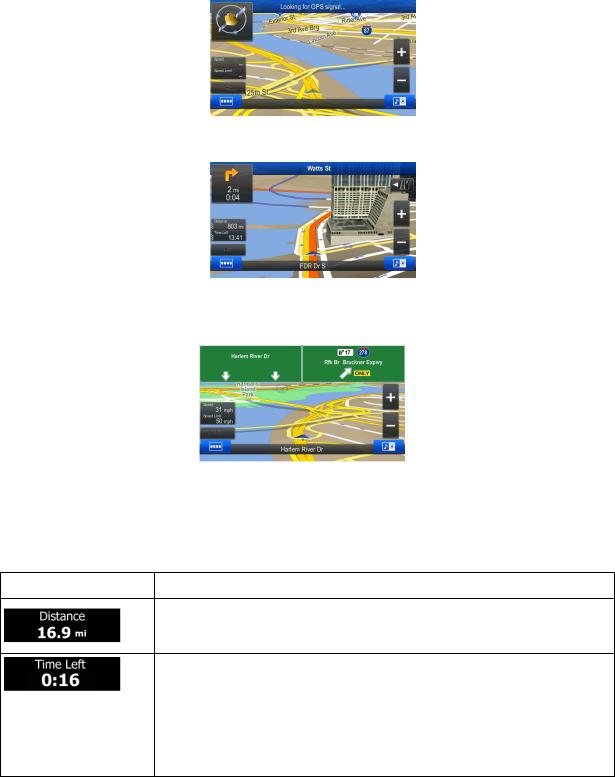
When GPS position is available, the Vehimarker is displayed in full color, now showing your current position.
There are screen buttons and data fields on the screen to help you navigate. During navigation, the screen shows route information.
Two data fields are displayed on the left.
The data fields are different when you are navigating an active route and when you have no specified destination (the orange line is not displayed).
There are no data fields without a given destination.
Default data fields when navigating a route (tap any of the fields to change its value):
Field |
Description |
Shows the distance you need to travel on the route before reaching your final destination.
Shows the time needed to reach the final destination of the route based on information available for the remaining segments of the route.
If your device is capable of receiving live traffic information, the calculation takes into account traffic delays affecting your route if they are received. However, this calculation is rarely accurate.
Historical traffic data can also be taken into account if data is available.
There are three map view modes. Tap the button below the data fields to change the view:
12
∙ : 3D perspective view rotated in your direction of travel.
: 3D perspective view rotated in your direction of travel.
∙ : 2D top-down view facing North.
: 2D top-down view facing North.
∙ : 2D top-down view rotated in your direction of travel.
: 2D top-down view rotated in your direction of travel.
13
2.2.2Position markers
2.2.2.1Vehimarker and Lock-on-Road
When your GPS position is available, the software marks your current position with the Vehimarker. By default, this marker is a blue arrow, but you can change this icon in Settings.
When on-road navigation is selected, the Vehimarker may not show your exact GPS position and heading. If roads are near, it is aligned to the nearest road to suppress GPS position errors, and the direction of the icon is aligned to the direction of the road.
If you select off-road navigation: The Vehimarker is at your exact GPS position. The direction of the icon shows your current heading.
2.2.2.2 Selected map location (Cursor) and selected map object
You can mark a map location in the following ways:
∙Tap the map when navigating,
∙Tap the map when you are asked to confirm the destination at the end of a search, or
∙Tap the map in Find on Map (page 49)
When a map location is selected, the Cursor appears at the selected point on the map. The Cursor is
displayed with a radiating red dot ( ) to make it visible at all zoom levels.
) to make it visible at all zoom levels.
The location of the Cursor can be used as the destination of the route, a new alert point, you can search for Places around it, or you can save this location as one of your Favorite destinations.
You can also select some of the objects on the map. If you tap the map at the icon of a Place of Interest or an alert point, the object will be selected (you see a red circling border around the object), and you can get information about this object or use it as a route point.
2.2.3Objects on the map
2.2.3.1Streets and roads
The software shows the streets in a way that is similar to how the paper road maps show them. Their width and colors correspond to their importance: you can easily tell a freeway from a small street.
14

2.2.3.2 Turn preview and Next street
When navigating a route, the top section of the Map screen shows information about the next route event (maneuver) and the next street or the next city/town.
There is a field in the top left corner that displays the next maneuver. Both the type of the event (turn, traffic circle, exiting freeway, etc.) and its distance from the current position are displayed.
Most of these icons are very intuitive. The following table lists some of the frequently shown route events.
Icon |
Description |
|
|
|
Turn left. |
|
|
|
Turn right. |
|
|
|
Turn back. |
|
|
|
Bear right. |
|
|
|
Turn sharp left. |
|
|
|
Keep left. |
|
|
|
Continue straight in the intersection. |
|
|
|
Go left on the traffic circle, 3rd exit. |
|
|
|
Enter freeway. |
|
|
|
Exit freeway. |
|
|
|
Board ferry. |
|
|
|
Leave ferry. |
|
|
15
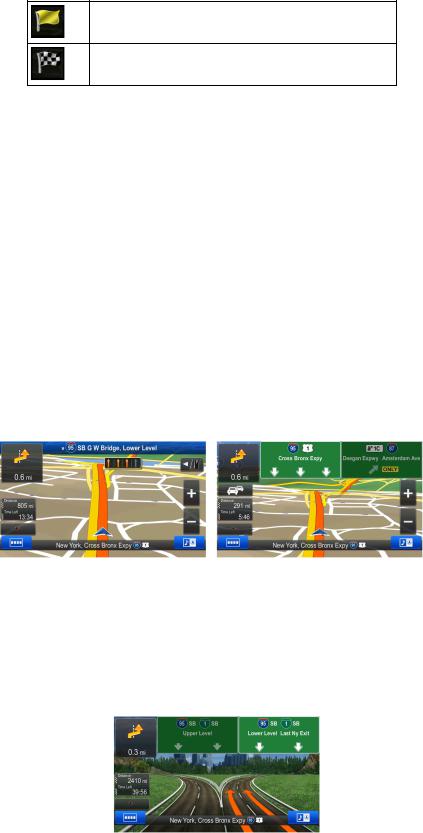
Approaching a waypoint.
Approaching the destination.
These fields also act as buttons:
∙Tap the Turn preview field and the voice guidance will repeat the latest instruction with updated distance information.
∙Tap the Next street field to open the Itinerary.
2.2.3.3 Lane information and Signposts
When navigating on multilane roads, it is important to take the appropriate lane in order to follow the recommended route. If lane information is available in the map data, the software displays the lanes and their directions using small arrows at the top of the map. Highlighted arrows represent the lanes you need to take.
Where additional information is available, signposts substitute arrows. Signposts are displayed at the top of the map. The color and style of the signposts are similar to the real ones you can see above road or by the roadside. They show the available destinations and the number of the road the lane leads to.
All signposts look similar when cruising (when there is no recommended route). When navigating a route, only the signpost that points to the lane(s) to be taken is displayed in vivid colors; all others are darker.
If you want to hide the currently displayed signposts, tap any of them and the normal Map screen returns until new signpost information is received.
This feature can be turned off in Visual Guidance settings.
2.2.3.4 Junction view
If you are approaching a freeway exit or a complex intersection and the needed information exists, the map is replaced with a 3D view of the junction. The lanes you need to take are displayed with arrows. Signposts can also be present if information is available.
If you want to hide the currently displayed junction, tap the picture and the Map screen returns.
16
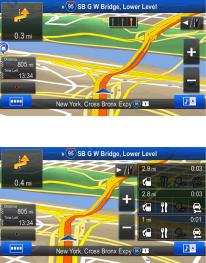
This feature can be turned off in Visual Guidance settings.
2.2.3.5 Freeway exit services
You may need a gas station or a restaurant during your journey. This feature displays a new button on the map when you are driving on freeways.
Tap this button to open a panel with the details of the next few exits or service stations.
Tap any of them to display it on the map and add it as a waypoint to your route if needed.
If you want to display other types of Places for the exits, you can change the icons in Visual Guidance settings (page 79).
2.2.3.6 3D object types
Your software supports the following 3D object types:
Type |
Description |
|
|
3D terrain |
3D terrain map data shows changes in terrain, elevations or depressions in the land |
|
when you view the map in 2D, and use it to plot the route map in 3D when you |
|
navigate. Hills and mountains are shown in the background of the 3D map, and |
|
illustrated by color and shading on the 2D map. |
|
|
Elevated roads |
Complex intersections and vertically isolated roads (such as overpasses or bridges) |
|
|
|
are displayed in 3D. |
|
|
3D landmarks |
Landmarks are 3D artistic or block representations of prominent or well-known |
|
objects. |
|
|
3D buildings |
3D block representation of full city building data containing actual building size and |
|
|
|
position on the map. |
|
|
17
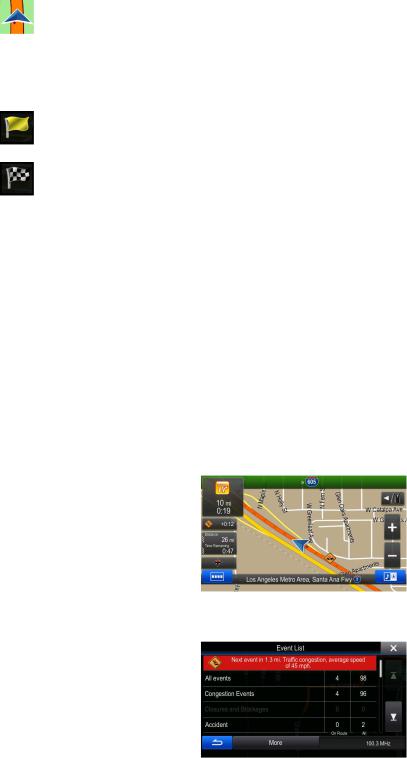
2.2.3.7 Elements of the active route
Your software shows the route in the following way:
Symbol |
|
Name |
Description |
|
|
|
|
|
Current GPS position and Start |
Your current position displayed on the map. If roads are |
|
|
point |
|
|
|
|
near, it is aligned to the nearest road. |
|
|
|
|
|
|
|
|
Normally if GPS position is available, the route starts |
|
|
|
from the current position. If there is no valid GPS |
|
|
|
position, your software uses the last known position as |
|
|
|
the start point. |
|
|
|
|
|
Waypoint |
(intermediate |
An intermediate destination of the route before reaching |
|
destination) |
||
|
the final destination. |
||
|
|
|
|
|
|
|
|
|
Destination (end point) |
The final destination of the route. |
|
|
|
|
|
|
Route color |
The route always stands out with its color on the map, |
|
|
|
|
|
|
|
|
both in daytime and in night color mode. |
|
|
|
|
|
Streets and roads that are |
You can choose whether you want to use or avoid |
|
|
excluded from the navigation |
certain road types (page 74). However, when your |
|
|
|
|
software cannot avoid such roads, the route will include |
|
|
|
them and it will show them in a color that is different |
|
|
|
from the route color. |
|
|
|
|
|
Streets and roads that are |
Road segments may be affected by traffic events |
|
|
affected by traffic events |
received. These streets and roads are displayed in an |
|
|
|
|
alternate color, and small symbols displayed along the |
|
|
|
route show the type of the traffic event. |
|
|
|
|
2.2.3.8 Traffic events
Road segments affected by traffic events are displayed with an alternate color on the map, and small symbols above the road show the nature of the event:
Tap  to open the list of traffic event categories:
to open the list of traffic event categories:
18

In the first column you can see the number of traffic events on your route. The second column contains the full count of traffic events in the categories.
Tap any of the even types to list the event in that category or select the top row to open the list of all traffic events:
Now tap any of the list items to see its details, and to display the affected road segment in its full length on the map:
2.2.4 Manipulating the map
Tap the map anywhere to browse it during navigation. The map stops following the current position (the Vehimarker, a blue arrow by default, is not locked in a fix position on the screen any more) and control buttons appear to help you modify the map view.
Action |
Button(s) |
Description |
|
|
|
Moving the map with |
No buttons |
You can move the map in any direction: tap and hold |
drag&drop |
|
|
|
the map, and move your finger towards the direction |
|
|
|
|
|
|
you want to move the map. |
|
|
|
19

Zooming in and out |
|
|
Changes how much of the map is displayed on the |
|
|
|
|
|
, |
|
screen. |
|
|
Your software uses high-quality vector maps that let |
|
|
|
|
|
|
|
|
you examine the map at various zoom levels, always |
|
|
|
with optimized content. It always displays street |
|
|
|
names and other text with the same font size, never |
|
|
|
upside-down, and you only see the streets and |
|
|
|
objects that you need. |
|
|
|
Map scaling has a limit in 3D map view mode. If you |
|
|
|
zoom out further, the map switches to 2D view mode. |
|
|
|
Tap the button once to modify the view in large |
|
|
|
steps, or tap and hold the button to modify it |
|
|
|
continuously and smoothly. |
|
|
|
|
Tilting up and down |
|
|
Changes the vertical view angle of the map in 3D |
|
|
|
|
|
, |
|
mode. |
|
|
|
Tap the button once to modify the view in large |
|
|
|
steps, or tap and hold the button to modify it |
|
|
|
continuously and smoothly. |
|
|
|
|
Rotating left and right |
|
|
Changes the horizontal view angle of the map. |
|
|
|
|
|
, |
|
Tap the button once to modify the view in large |
|
|
|
steps, or tap and hold the button to modify it |
|
|
|
continuously and smoothly. |
|
|
|
|
Compass |
|
|
Tap this button to cycle between a 3D perspective |
|
, |
, |
and two 2D top-down map view modes. |
|
|
||
|
|
|
|
Location information |
|
|
Tap this button to open a new screen with |
|
|
|
|
|
|
|
information about the selected map point, the Cursor. |
|
|
|
|
Return to normal |
|
|
Tap this button to move the map back to follow the |
navigation |
|
|
|
|
|
current GPS position. Automatic map rotation is also |
|
|
|
|
|
|
|
|
re-enabled. |
|
|
|
The map manipulation buttons disappear and |
|
|
|
navigation continues. |
|
|
|
|
Additional options |
|
|
Tap this button to open a list of additional features |
|
|
|
|
|
|
|
like saving the Cursor as an Address Book entry, or |
|
|
|
searching for Places around the Cursor. |
|
|
|
|
Select destination |
|
|
Tap this button to select the Cursor as a new |
|
|
|
|
|
|
|
destination. |
|
|
|
|
20
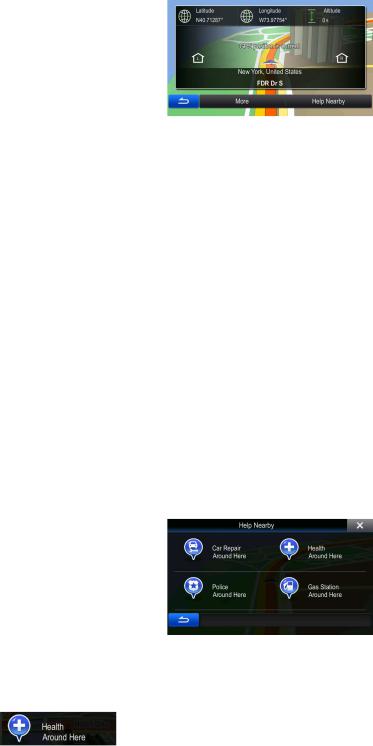
2.2.5 Checking the details of the current position (Where Am I?)
This screen contains information about the current position (or about the last known position if GPS reception is not available) and a button to search for useful Places nearby.
.
You can access this screen from the map in one of the following ways:
∙If the current street is displayed below the Vehimarker (the current position on the map), tap it to open the Where Am I? screen.
∙In the Navigation menu, tap  and then
and then  .
.
Information on this screen:
∙ ,
,  : Latitude and Longitude (coordinate of the current position in WGS84 format).
: Latitude and Longitude (coordinate of the current position in WGS84 format).
∙ : Altitude (elevation information coming from the GPS receiver - often inaccurate).
: Altitude (elevation information coming from the GPS receiver - often inaccurate).
∙Address details (when available) of the current position are also displayed at the bottom. You can also perform some actions on this screen:
Tap  to save the current position as an Address Book entry or to read the Country Information.
to save the current position as an Address Book entry or to read the Country Information.
You can also search for assistance near your current position. Tap  to open a new screen for the Quick search:
to open a new screen for the Quick search:
The following services can be searched around the current position or the last known position:
∙ : Car repair and roadside assistance services
: Car repair and roadside assistance services
∙ |
: Medical and emergency services |
21
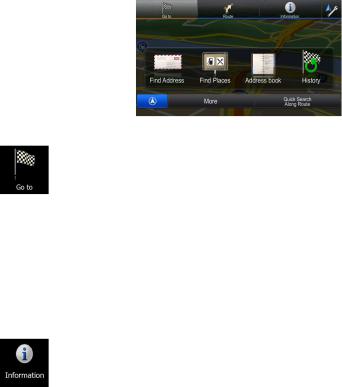
∙ : Police stations
: Police stations
∙ : Gas stations
: Gas stations
Tap any of the buttons, select a Place from the list, and navigate to it.
2.3 Navigation menu
You can reach all parts of the software from the Navigation menu. When you open the menu, the destination search buttons appear on the screen. Tap any other menu button at the top and their feature buttons appear below.
You have the following menus:
∙ Tap to select your destination by entering an address or selecting a place of interest, a location on the map or one of your Address Book entries. You can also look up your recent destinations from the History, enter a coordinate or use the location saved in a photo. You can also use the free form search.
∙Tap  to display the route parameters and the route in its full length on the map. You can also perform route-related actions such as editing or canceling your route, setting a start point for the route, picking route alternatives, avoiding parts of the route or simulating navigation.
to display the route parameters and the route in its full length on the map. You can also perform route-related actions such as editing or canceling your route, setting a start point for the route, picking route alternatives, avoiding parts of the route or simulating navigation.
∙ |
Tap |
to get information about your current position, the GPS reception or the trips you |
|
have taken or to run some additional applications.. |
|
∙Tap  to customize the way the navigation software works.
to customize the way the navigation software works.
∙Press the MAP hardware button to start navigating on the map.
22
3 On-road navigation
When first started, Alpine unit calculates routes using the road network of the high quality vector maps provided with the product.
You can set up your route in different ways:
∙If you need a route for immediate navigation, you can select the destination and start navigating to it right away (normal navigation).
∙You can also plan a route independently of your current GPS position or even without GPS reception (to achieve this, you need to turn off the GPS receiver and set a new starting point in Route / Edit Route by tapping the flag icon at the current position).
You can plan routes with multiple destinations. Select the first destination. Then select a second destination and add it to your route to create a multi-point route. You can add as many destinations to your route as you like.
You can also use Alpine unit for off-road navigation. For details, see page 63.
3.1 Selecting the destination of a route
The software offers you several ways of choosing your destination:
∙Enter a full address or a part of an address, for example a street name without a house number or the names of two intersecting streets (page 23).
∙Enter an address with ZIP code (page 36). This way you do not need to select the name of the city/town and the search for street names might be faster as well.
∙Use a built-in Place of Interest as your destination (page 39).
∙Use the free form search to find an address or Place (page 48).
∙Select a location on the map with the Find on Map feature (page 49).
∙Use a previously saved Address Book entry (page 50).
∙Select a location from the History of previously used destinations (page 51).
∙Enter the coordinate of the destination (page 52).
∙Use the location where a photo was taken (page 53).
3.1.1 Entering an address or a part of the address
If you know at least a part of the address, it is the quickest way to select the destination of the route. Using the same screen, you can find an address by entering:
∙the exact address, including house number
∙the center of a city/town
∙an intersection
∙the midpoint of a street
23
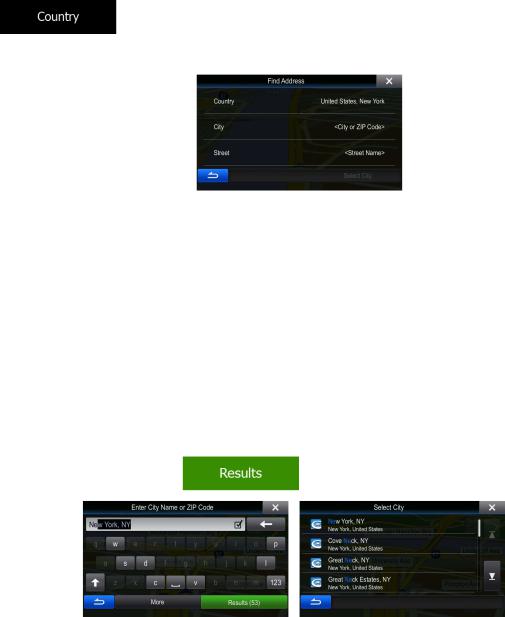
∙ any of the above, starting the search with the ZIP code (page 36) You can also search for an address with the free form search (page 48).
3.1.1.1 Entering an address (United States)
To enter an address as the destination, do as follows:
1.In the Navigation menu, tap the following buttons:  ,
,  .
.
2.By default, the software proposes the country and state where you are. If needed, tap
, enter the first few letters of the destination country or state on the keyboard, and select one from the list. If you select a country without a state, you can search for a city/town in all its states.
3.Select a new city/town:
a.Tap  . The city/town of your current location is offered by default. For a local search, tap
. The city/town of your current location is offered by default. For a local search, tap  to accept it, otherwise continue with entering the destination city/town name.
to accept it, otherwise continue with entering the destination city/town name.
b.Start entering the name of the city/town on the keyboard.
c.Find the city/town you need:
∙The most likely city/town name is always shown in the input field. To accept it, tap  .
.
∙If the desired name does not show up, the names that match the string appear in a list after entering a couple of characters (to open the list of results before it appears
automatically, tap |
). Select the city/town from the list. |
24
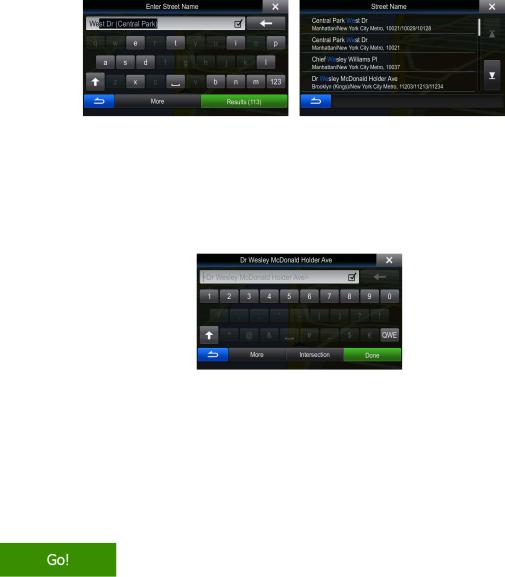
4.Enter the street name:
a.Start entering the street name on the keyboard.
b.Find the street you need:
∙The most likely street name is always shown in the input field. To accept it, tap  .
.
∙If the desired name does not show up, the names that match the string appear in a
list after entering a couple of characters (to open the list of results before it appears automatically, tap  ). Select the street from the list.
). Select the street from the list.
5.Enter the house number:
a.Enter the house number on the keyboard. (To enter symbols, tap  ).
).
b.Tap  to finish entering the address. (If the entered house number cannot be found, the midpoint of the street is selected as the destination.)
to finish entering the address. (If the entered house number cannot be found, the midpoint of the street is selected as the destination.)
6.A full screen map appears with the selected point in the middle. If necessary, tap the map somewhere else to modify the destination. The Cursor ( ) appears at the new location. Tap
) appears at the new location. Tap  to confirm the destination, or tap
to confirm the destination, or tap  to select a different destination.
to select a different destination.
7.After a short summary of the route parameters, the map appears showing the entire route. The
route is automatically calculated. Tap  to modify route parameters, or tap
to modify route parameters, or tap
and start your journey.
25
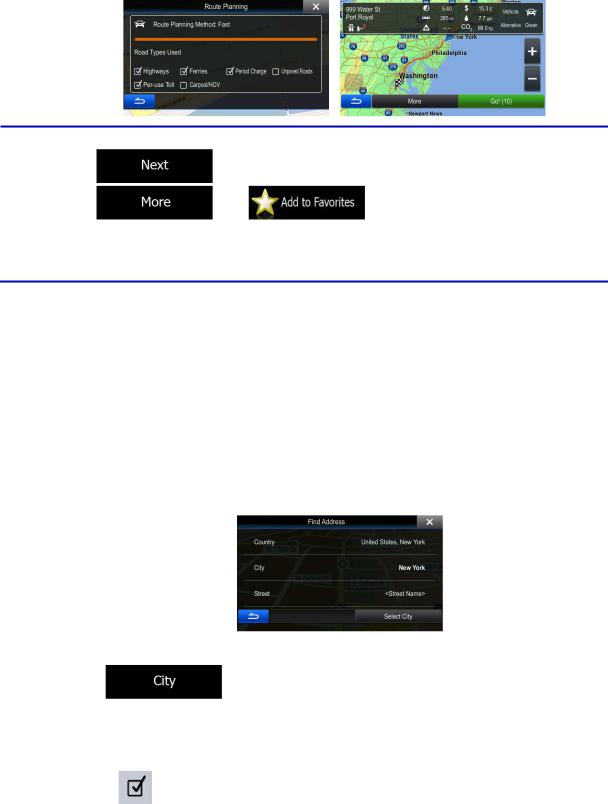
 Tip! If you know that you will use this destination frequently, before tapping
Tip! If you know that you will use this destination frequently, before tapping
to confirm the destination, put it in the Address Book first: tap
then , give a name for the new entry, and tap
 to save the location. The map with the destination returns automatically. Now you can start your journey.
to save the location. The map with the destination returns automatically. Now you can start your journey.
3.1.1.2 Entering an address (Canada)
To enter an address as the destination, do as follows:
1.In the Navigation menu, tap the following buttons:  ,
,  .
.
2.By default, the software proposes the country, state and city/town where you are. If needed, tap  , enter the first few letters of the destination country or state on the keyboard, and select one from the list. If you select a country without a state, you can search for a city/town in all its states.
, enter the first few letters of the destination country or state on the keyboard, and select one from the list. If you select a country without a state, you can search for a city/town in all its states.
3.If needed, select a new city/town:
a. Tap |
. |
b.Start entering the name of the city/town on the keyboard.
c.Find the city/town you need:
∙The most likely city/town name is always shown in the input field. To accept it, tap
.
26
